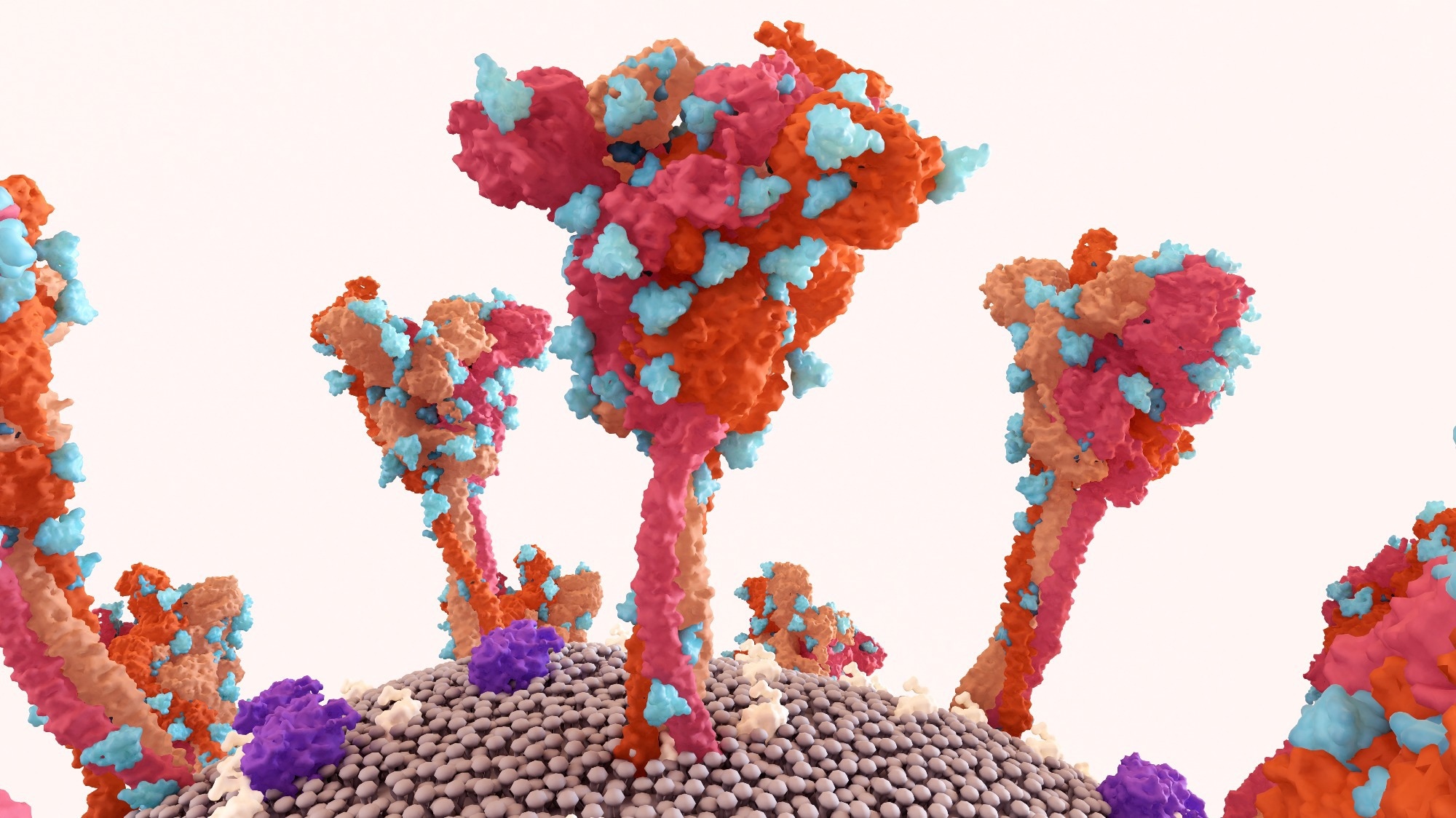In a recent study posted to the bioRxiv* preprint server, an international team of researchers developed a second-generation severe acute respiratory syndrome coronavirus 2 (SARS-CoV-2) receptor binding domain (RBD) antigen (RBD-J6) by molecular engineering with two additional amino acid (aa) substitutions (S383D and L518D mutations) in a hydrophobic cryptic RBD core epitope to enhance stability and expression against SARS-CoV-2 variants of concern (VOCs).
 Study: Molecular engineering of a cryptic epitope in Spike RBD improves manufacturability and neutralizing breadth against SARS-CoV-2 variants. Image Credit: Design_Cells / Shutterstock
Study: Molecular engineering of a cryptic epitope in Spike RBD improves manufacturability and neutralizing breadth against SARS-CoV-2 variants. Image Credit: Design_Cells / Shutterstock
Sarbecovirus vaccines that can be produced and distributed among low- and middle-income nations are required. Subunit proteinaceous vaccines have been manufactured cost-effectively at a large scale with convenient thermal requirements, of which several vaccines have demonstrated anti-SARS-CoV-2 efficacy.
The study's authors previously performed molecular engineering experiments to improve RBD production and stability in yeast. As a result, they developed an engineered variant of SARS-CoV-2 spike (S) protein RBD antigen (RBD-J) with improved immunogenicity and manufacturability in comparison to the ancestral (Wuhan-Hu-1) strain RBD.
About the study
In the present study, researchers expanded their previous analysis by performing further molecular engineering analyses of the engineered SARS-CoV-2 RBD.
A hydrophobic patch on the RBD core proximal to the C-terminus was modified [reduced or eliminated by mutations] to improve RBD stability, solubility, and secretion. For the analysis, 21 aa substitutions were selected that were previously reported to boost RBD expression in yeast while preserving angiotensin-converting enzyme (ACE2) binding ability. Each of them was assessed individually. Each RBD contained the L452K mutation, which had been shown to improve RBD stability and expression by the authors previously.
Each RBD variant was transferred into yeast for RBD secretion assessment. Combinations of three aspartic acid mutations, including the L452K and F490W mutations in the receptor-binding motif (RBM) of the RBD core's hydrophobic patch, were evaluated. The physiological properties of RBD-J6 and RBD-J were compared. Far-UV circular dichroism (CD) spectroscopy, differential scanning calorimetry (DSC), static light scattering (SLS), reverse phase high-performance liquid chromatography (HPLC), and biolayer interferometry (BLI) experiments were performed.
RBD-J6 binding to ACE2 and several nAbs (neutralizing antibodies) targeting different RBD epitopes was assessed. Next, the team evaluated polyclonal Ab raise in RBD-J bound to RBD-J6-vaccinated mice and binding of serological Abs obtained from SARS-CoV-2 Delta VOC-infected and coronavirus disease 2019 (COVID-19) messenger ribonucleic acid (mRNA) vaccine-immunized convalescents to the initially (RBD-J) and subsequently (RBD-J6) engineered RBDs was evaluated. The team investigated if manufacturability and stability benefits obtained from introducing mutations in RBD-J6's hydrophobic patch would also benefit RBD antigens containing Alpha and Beta VOCs mutations.
Three Beta VoC RBD mutations (K417N, E484K, and N501Y) were added to RBD-J6 (referred to as RBD-J6 β hereafter). The Beta VOC mutation-containing initially and subsequently engineered RBDs conjugated with HBsAg VLP (Hepatitis B surface antigen virus-like particle) immunogenicity were compared. Further, K18-hACE2 (human ACE2) transgenic mice were intramuscularly administered either alum-adjuvanted VLP–RBD conjugate or Pfizer-BioNTech's mRNA vaccine twice three weeks apart to determine the effects of RBD-J6 aa substitutions on the engineered vaccine's immunogenicity.
Serological responses were assessed against SARS-CoV-2 VOC RBDs after two weeks, five weeks, and seven weeks of vaccination. After seven weeks, K18-hACE2 mice vaccinated with RBD-J β and RBD-J6 β were challenged with Alpha VOC or Beta VOC. In addition, SARS-CoV-2 RNA titers in mice cranial and pulmonary tissues were determined, and SARS-CoV-2 VOC neutralization was evaluated.
Results
RBD-J6 showed binding with sera of Delta convalescent individuals and for all nAbs tested except the RBD core class IV epitope-targeting nAbs (EY6A and CR3022). The hydrophobic patch modification improved RBD secretion titers three-fold and enhanced stability; however, the modifications did now show significant differences in RBD immunogenicity or antigenicity.
Conjugated VLP-RBD induced cross-reactive immunity in mice against SARS-CoV-2 VOCs such as Alpha and Beta. Additional mutations in RBD-J6 improved RBD productivity four-fold compared to the ancestral strain RBD, and three aspartic acid mutations (S383D, R408D, and L518D) most prominently improved RBD expression from 60mg/L to 173mg/L. Further, RBD-J6 showed lowered surface hydrophobicity. The Tm (thermal melting temperature) of RBD-J6 (63°C) was higher than that of RBD-J in all temperature-based analyses, indicative of higher conformational and colloidal stability of RBD-J6, and the engineered RBD was destabilized by aluminum and CpG adjuvants.
Vaccination status did not alter the binding affinity of both the engineered RBDs for ACE2, Delta convalescent sera, and the nAbs tested. RBD-J6 β also showed similar ACE2 binding as RBD-J6, and no increase in ACE2 binding was noted by adding Alpha and Beta VOC RBD mutations. SARS-CoV-2 RNA tires were 30% lower in the brain and lungs of mice in the case of RBD-J6 β expression compared to RBD-J6 expression, and lungs showed lesser inflammation post-Alpha VOC or Beta VOC challenge. The cross-neutralization potencies of the VLP – RBD-J6 β conjugate and Pfizer's mRNA COVID-19 vaccine were comparable.
Overall, the study findings highlighted the potential use of the RBD-J6 for improved development of RBD-based subunit vaccines, with better manufacturability, stability, and access to low- and middle-income nations.
*Important notice
bioRxiv publishes preliminary scientific reports that are not peer-reviewed and, therefore, should not be regarded as conclusive, guide clinical practice/health-related behaviour, or treated as established information.
- Molecular engineering of a Spike RBD's cryptic epitope improves manufacturability and neutralizes breadth against SARS-CoV-2 variants. Sergio A. Rodriguez-Aponte et al. medRxiv preprint 2022, DOI: https://doi.org/10.1101/2022.09.14.507842, https://www.biorxiv.org/content/10.1101/2022.09.14.507842v1
Posted in: Molecular & Structural Biology | Medical Research News | Disease/Infection News | Pharmaceutical News
Tags: ACE2, Amino Acid, Angiotensin, Antibodies, Antigen, Aspartic Acid, binding affinity, Brain, Chromatography, Coronavirus, Coronavirus Disease COVID-19, covid-19, CpG, Efficacy, Enzyme, Hepatitis, Hepatitis B, immunity, Inflammation, Liquid Chromatography, Lungs, Mutation, Protein, Receptor, Respiratory, Ribonucleic Acid, RNA, SARS, SARS-CoV-2, Severe Acute Respiratory, Severe Acute Respiratory Syndrome, Spectroscopy, Syndrome, Transgenic, Vaccine, Virus, Yeast

Written by
Pooja Toshniwal Paharia
Dr. based clinical-radiological diagnosis and management of oral lesions and conditions and associated maxillofacial disorders.
Source: Read Full Article
